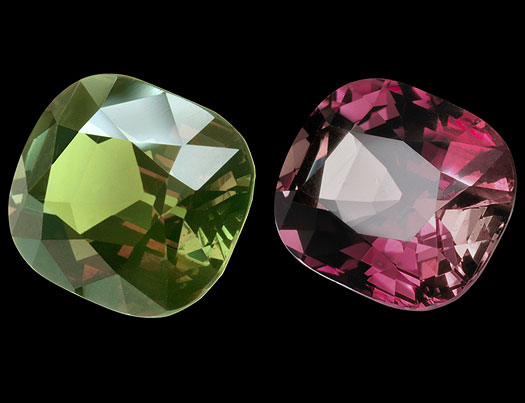Alexandrite – Alexandrite An Emerald by Day, An Amethyst by Night
If you love magic, especially the magic of science, you’ll love alexandrite, the colour-change gem. Outside in daylight, it is a cool bluish mossy green. Inside in lamplight, it is a red gem, with a warm raspberry tone. You can watch it flick back and forth by switching from fluorescent to incandescent light.
The year was 1830, when Ekaterinburg (named for the Russian Empress Catherine II) was a bustling city on the route from Russia to Siberia. The date was April 23, the date of the young Czarevitch Alexander Nicolajevitch’s birthday, when as legend goes, a new gem was discovered and created a sensation. A variety of chrysoberyl was found that was bright green in daylight and rich red when seen under artificial light at night. Now red and green were also the colours of the Russian Imperial flag and thus the gem was named Alexandrite by mineralogist Nordenskjold in honour of the future ruler of the Russian Empire who would go on to rule as Czar Alexander II from 1855-1881.
Siberia. The date was April 23, the date of the young Czarevitch Alexander Nicolajevitch’s birthday, when as legend goes, a new gem was discovered and created a sensation. A variety of chrysoberyl was found that was bright green in daylight and rich red when seen under artificial light at night. Now red and green were also the colours of the Russian Imperial flag and thus the gem was named Alexandrite by mineralogist Nordenskjold in honour of the future ruler of the Russian Empire who would go on to rule as Czar Alexander II from 1855-1881.
How does the colour change work? Most gems transmit and absorb light throughout the visible spectrum and we interpret the mixture of the transmitted wavelengths as the gem’s colour. Alexandrite transmits light only in two discrete windows of the spectrum, in the blue-green and red regions. The rest of the spectrum is absorbed. When viewed under light sources active in those particular regions of transmission, you see one of the two colours. In daylight, or in artificial light that simulates it, like fluorescent light, light waves in the green region predominate. In candlelight, or artificial light that simulates it like incandescent or tungsten light, light waves in the red region predominate. The gem is displaying changes in the light, not changing itself.
Today, fine alexandrite is most often found in period jewellery since newly-mined gems are extremely rare. You’ll see fine gems offered at auction with impressive estimates. The original source in Russia’s Ural Mountains has long since closed after producing for only a few decades and only a few stones can be found on the market today. Material with a certificate of Russian origin is still particularly valued by the trade. Some alexandrite is found in Sri Lanka and Zimbabwe and Brazil but very little shows a dramatic colour change. For many years, alexandrite was almost impossible to find because there was so little available.
Then in 1987, a new find of alexandrite was made in Brazil at a locality called Hematita. The Hematita alexandrite shows a striking and attractive colour change from raspberry red to bluish green. Although alexandrite remains extremely rare and expensive, the production of a limited amount of new material means a new generation of jewellers and collectors have been exposed to this beautiful gemstone, creating an upsurge in popularity and demand.
Although natural alexandrite is not usually subjected to any colour or clarity enhancement techniques, synthetic versions of the gem do exist and are often difficult to tell from the natural stone. Alexandrite was first synthesised in 1973 and Chatham created alexandrite was synthesised in 1975. Often it is also imitated by synthetic corundum (mostly synthetic colour change sapphire coloured by vanadium) and synthetic spinel. The synthetic versions change from grey/blue violet in daylight to a reddish violet in incandescent lighting. Synthetics also tend to have flux inclusions, triangular metallic platelets, curved striae, or gas bubbles, depending on the technique used to create them. Synthetic alexandrite also tends to have a slightly lower refractive index, and exhibits stronger fluorescence than the natural gems.
Alexandrite is the rarest variety of chrysoberyl (BeAl O ), which occurs in granitic pegmatites and mica schists. Small scale replacement of alumina by chromium oxide results in the formation of alexandrite and is also responsible for the stone’s dramatic colour change. Two very rare varieties of alexandrite are the cat’s eye alexandrite and the star alexandrite. Alexandrite has a high degree of hardness, 8.5 on the Moh’s Scale. It can thus weather daily wear but it should be protected from sharp blows and scratches, as well as from harsh chemicals and excessive heat. Therefore, it makes sense to be careful about getting alexandrite remounted as heat from the jeweller’s torch may have an adverse effect on the colour change. It can be cleaned in ultrasonic cleaners but not for more than 3-5 minutes. Alexandrite has a specific gravity of 3.74 and a refractive index of 1.746-1.755. Its crystal system is orthorhombic.
When evaluating alexandrite, pay the most attention to the colour change: the more dramatic and complete the shift from red to green, without the bleeding through of brown from one colour to the next, the more rare and valuable the stone. The other important value factors are the attractiveness and intensity of the two colours, the clarity, and the cutting quality. Due to rarity, large sizes command very high premiums.

